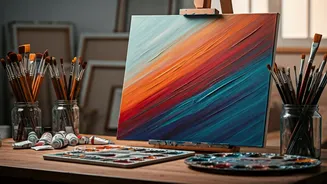Painting's Healing Touch
Painting provides a unique outlet for emotional expression, acting as a therapeutic tool for individuals to process and manage their feelings. Sonakshi
Sinha, for instance, once shared that she stopped painting when she met her husband, highlighting the role art played in her life. Painting provides a safe and private space where one can explore their inner world without judgment. The act of creating something tangible from one's emotions can be incredibly empowering and cathartic. When engaging in this activity, individuals can confront anxieties and tensions in a creative environment, transforming negative thoughts into something beautiful. This transformation can boost one's mood and improve overall mental wellbeing by fostering self-awareness and self-compassion.
Art as Coping Tool
Art serves as a powerful coping mechanism, especially during challenging times. It can serve as a distraction from worries, allowing individuals to lose themselves in the creative process. Painting allows individuals to communicate their emotions through colors, shapes, and textures, which might be difficult to articulate verbally. The process of creation can offer a sense of accomplishment and control, providing a much-needed boost in confidence and self-esteem. In moments of stress or sadness, painting can act as a sanctuary, offering a space to calm down and regain emotional balance. Art as a coping method provides a constructive way to process trauma, grief, and other difficult experiences, promoting healing and resilience. It encourages self-reflection and fosters a deeper understanding of one's own emotional landscape.
Getting Started: Tips
Starting your painting journey does not need to be difficult, it is better to start simple and build from there. Begin with basic supplies like paper, pencils, and a set of paints. You may not need a wide variety of expensive supplies at the beginning. Watch tutorials online or take a beginner's class to learn basic techniques. Don't be afraid to experiment with different styles and methods to see what works best for you. Practice regularly, and don't worry about perfection; focus on the process rather than the result. Finding inspiration is simple; observe the world around you, and consider what images or feelings resonate with you. Embrace the joy of creating; remember that painting is a personal journey and a way to express yourself.
Benefits of Painting
Painting offers many mental health benefits. It reduces stress and anxiety by providing a calming and engaging activity to redirect your focus. Painting cultivates mindfulness, encouraging you to be present in the moment and observe your surroundings closely. It boosts self-esteem as you see your skills and creative abilities improve over time. Painting is a form of self-expression, allowing you to connect with your emotions and share your inner world. It enhances cognitive function by encouraging creativity, problem-solving, and attention to detail. This also contributes to increased brain function and promotes relaxation. Through painting, one can achieve a sense of accomplishment and develop a fulfilling hobby that improves mental wellbeing.
















